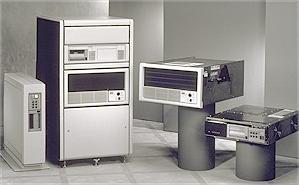Difference between revisions of "PDP-11/93"
(Identify more exactly) |
|||
| Line 1: | Line 1: | ||
[[Image:pdp11_93_94.jpg|thumb|right|200xp|PDP-11 models 93 & 94]] | [[Image:pdp11_93_94.jpg|thumb|right|200xp|PDP-11 models 93 & 94]] | ||
| − | + | The ''PDP-11/93'' was part of the last generation of DEC-produced [[PDP-11]]'s; it was [[QBUS]] only, its [[UNIBUS]]-capable twin being the [[PDP-11/94]]. Both used the [[KDJ11-E]] CPU. | |
| − | It | + | It ran at 1 VUPS, making the 93/94 the fastest PDP-11. |
== hampage.hu == | == hampage.hu == | ||
Quote: | Quote: | ||
<i> | <i> | ||
| − | Introduced in 1990. The last of the original (DEC) PDP-11s. Technically it is a re-enginered [[PDP-11/83]] (it uses the same J-11 CPU) with more modern components (it could be modified for 20MHz clock frequency), and 2 or 4 MB's of on-board | + | Introduced in 1990. The last of the original (DEC) PDP-11s. Technically it is a re-enginered [[PDP-11/83]] (it uses the same J-11 CPU chip) with more modern components (it could be modified for 20MHz clock frequency), and 2 or 4 MB's of on-board ECC RAM. It also features eight buffered serial lines (a terminal multiplexer emulated by a Z80) on the processor board. |
</i> | </i> | ||
{{stub}} | {{stub}} | ||
{{PDP-11}} | {{PDP-11}} | ||
| − | [[Category:DEC processors]][[Category:QBUS processors]] | + | [[Category:DEC processors]] |
| + | [[Category:QBUS processors]] | ||
Revision as of 14:00, 2 June 2016
The PDP-11/93 was part of the last generation of DEC-produced PDP-11's; it was QBUS only, its UNIBUS-capable twin being the PDP-11/94. Both used the KDJ11-E CPU.
It ran at 1 VUPS, making the 93/94 the fastest PDP-11.
hampage.hu
Quote: Introduced in 1990. The last of the original (DEC) PDP-11s. Technically it is a re-enginered PDP-11/83 (it uses the same J-11 CPU chip) with more modern components (it could be modified for 20MHz clock frequency), and 2 or 4 MB's of on-board ECC RAM. It also features eight buffered serial lines (a terminal multiplexer emulated by a Z80) on the processor board.
| v • d • e PDP-11 Computers and Peripherals |
|---|
| UNIBUS PDP-11s - PDP-11/20 • PDP-11/15 • PDP-11/35 • PDP-11/40 • PDP-11/45 • PDP-11/50 • PDP-11/55 • PDP-11/70 PDP-11/05 • PDP-11/10 • PDP-11/04 • PDP-11/34 • PDP-11/60 • PDP-11/44 • PDP-11/24 • PDP-11/84 • PDP-11/94 QBUS PDP-11s - PDP-11/03 • PDP-11/23 • PDP-11/23+ • MicroPDP-11/73 • MicroPDP-11/53 • MicroPDP-11/83 • MicroPDP-11/93 QBUS CPUs: LSI-11 • LSI-11/2 • KDF11-A • KDF11-B • KDJ11-A • KDJ11-B • KDJ11-D • KDJ11-E Buses: UNIBUS • UNIBUS map • SPC • MUD • EUB • QBUS • CD interconnect • PMI Also: PDP-11 architecture • PDP-11 Extended Instruction Set • FP11 floating point • PDP-11 Memory Management |
| UNIBUS CPUs: KA11 • KC11 • KB11-A • KB11-B • KB11-C • KB11-D • KD11-A • KD11-B • KD11-D • KD11-E • KD11-EA • KD11-K • KD11-Z • KDF11-U
Co-processors: FP11-A • FP11-B • FP11-C • FP11-E • FP11-F • KE44-A • FPF11 Chips: LSI-11 • KEV11-A • KEV11-B • KEV11-C • F-11 • KEF11-A • KTF11-A • T-11 • J-11 • FPJ11 CPU options: KE11-E • KE11-F • KJ11-A • KT11-C • KT11-D • KK11-A • KK11-B • KT24 • KTJ11-B Rare CPU options: KS11 Memory Protection and Relocation option • KT11-B Paging Option • KUV11 Writeable Control Store Front panels: KY11-A • KY11-D • KY11-J • KY11-LA • KY11-LB • KY11-P More on buses: UNIBUS and QBUS termination • Bus Arbitration on the Unibus and QBUS • CTI BUS PDT-11s - PDT-11/110 • PDT-11/130 • PDT-11/150 CTI PDP-11s - PRO-325 • PRO-350 • PRO-380 Other: FIS floating point • PDP-11 Commercial Instruction Set • PDP-11 stacks • PDP-11 family differences |
